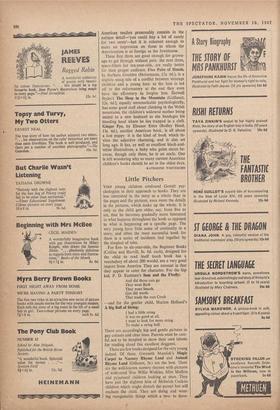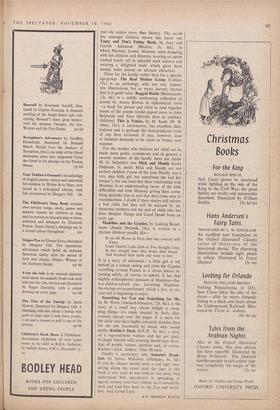Little Pitchers
VERY young children confound Gestalt psy- chologists in their approach to books. They are less interested in the story as a whole than in the pages and the pictures, even more the details in the pictures, which make up the whole. It is only as the child gets older, say, from five to six, that he becomes gradually more interested in what happens throughout the book as opposed to what is happening on a specific page. The very young have little sense of continuity in a story, and often the most successful book for them is a series of incidents tied together by the simplest of tales.
For five- to six-year-olds, the Beginner Books (Collins and Harvill, 8s. 6d. each), designed for the child to read itself (each book has a vocabulary of about 200 words), are a very good import from America. They are unusual in that they appear to cater for character. For the hip kid, P. D. Eastman's Sam and the Firefly:
And did those cars go They went Bash They went Smash.
Gus did words That made the cars Crash
—and for the gentler child, Marion Holland's A Big Ball of String:
1 had a little string It was no good at all, I went to look for more string To make a string ball.
There are accordingly hip and gentle pictures in gay colours and clear lines. Parents must be care- ful not to be tempted to show their own talents for reading aloud this excellent doggerel.
There are few books designed for the very young indeed. Of these, Gwyneth Mamlok's Magic Carpet to Nursery Rhyme Land and Animal Rhyme Land (Odhams, 5s.) are the best. These are the well-known nursery rhymes with pictures of wide-eyed Wee Willie Winkies, Miss Muffets and pyjamaed children looking at stars. They have just the slightest hint of Midwich Cuckoo children which might disturb the parent but will enchant the child. They are doing and wear- ing recognisable things which a two- to three-
year-old enjoys more than fantasy. The succes fou amongst children shown this batch was Topsy and Tim's Friday Book, by Jean and Gareth Adamson (Blackie, 3s. 6d.), in which Mummy ironed, Mummy went shopping with the children and Mummy wearing an apron cooked lunch—all in splendid stark colours and wearing a delighted smile which gives these menial tasks almost an ad-man attraction.
Three for the family rather than for a specific age-group: The Real Mother Goose (Collins, 15s.) is an anthology with not very impres- sive illustrations, but so many nursery rhymes that it is good value. Ragged Robin (Heinemann, 12s. 6d.) is a mildly enchanting collection of poems by James Reeves in alphabetical form —a book for parent and child to read together (some of the poems would appeal more to John Betjeman and Alan Melville than to ordinary children). This is Venice, by M. Sasek (W. H. Allen, 15s.), is informative, has excellent illus- trations and is perhaps the best-produced book of any here reviewed. It may, however, lead to insistent demands to be taken to Venice next summer.
For the mother who, believes her child can be made more polite, considerate and in general a
sweeter member of the family there are Annie M. G. Schmidt's two Mick and Mandy books (Odhams, 5s. each). Mick and Mandy are not perfect children emost of the time Mandy was a very nice little girl but sometimes she lost her temper'), but one feels that their relationship with Mummy is so understanding (most of the little difficulties end with Mummy giving them some- thing specially nice to eat) that they come near to exemplariness. I doubt if these stories will reform a bad child, but they .will be enjoyed by en- thusiastic mothers and the sort of child who has done Helpful Things and Good Deeds from an early age.
Madeline and the Gypsies, by Ludwig Bemel- mans (Andre Deutsch, 15s.), is written in a rhythm children usually like— In an old House in Paris that was covered with Vines,
Lived Twelve Little Girls in Two Straight Lines. In two straight lines they broke their bread And brushed their teeth and went to bed. '
It is a story of adventure a little girl is left behind at a school outing and joins the Gypsies travelling around France in a circus before re- turning safely, of course, to school. It has that slightly schizophrenic pleasure of Madeline-who- is-a-child-at-school also becoming Madeline- the-daring-circus-performer which a five- to six- year-old is beginning to enjoy.
Something for You and Something for Me, by M. Watts (Abelard-Schuman, 12s. 6d.), is the story of a small boy whose delight is swop- ping things—it's made unusual by lively illus- trations spread over the pages. It is more for the child who likes highly-coloured sketches than for the one fascinated by detail, who would prefer Karline's Duck (O.U.P., 9s. 6d.), a story of a rag-and-bone woman and her pet duck. its pages littered with amusing Searle-type draw- ings of people, houses, dustbins and, of course, Karline's duck. Author, Tilde Michels.
Finally a cautionary tale, Samson's Break- fast, by Sylvia Makower (Methuen, 8s. 6d.) If you by chance should meet a real tiger wan-
dering along the street (and the tiger in this
book is very real) do not faint or run away. Just understand him (psychiatry is spreading to , tigers), remove your hair-ribbon, tie it around his neck .and lead him back to the Zoo and break- fast. And Good Luck.
KAY SHERIDAN FOSTI R











































 Previous page
Previous page